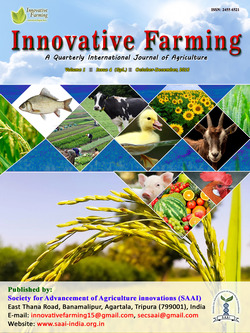
Extreme Streamflow Forecasting using Artificial Neural Networks
H.Y. Maheta*
P.G. Institute of Agri-Business Management, Junagadh Agricultural University, Junagadh, INDIA
H.D. Rank
Dept. of Soil and Water Conservation Engineering, College of Agricultural Engineering & Technology, Junagadh Agricultural University, Junagadh, INDIA
Jaydip J. Makwana
Centre of Excellence on Soil & Water Management, RTTC, Junagadh Agricultural University, Junagadh, INDIA
G.V. Prajapati
Dept. of Soil and Water Conservation Engineering, College of Agricultural Engineering & Technology, Junagadh Agricultural University, Junagadh, INDIA
DOI: NIL
Keywords: Artificial Neural Networks, Rainfall-runoff, Semi-arid Climate
Abstract
Forecasting of extreme stream flow is necessary for water resource planning and management at catchment scale. Artificial neural networks(ANN) have been widely used as models for a variety of nonlinear hydrologic processes including that of forecasting runoff over a watershed. In this study, ANN a data driven technique is used for forecasting the extreme streamflow. ANN architecture is optimized by selection of transfer function, training algorithm, hidden neurons, and initial weights. For ANN weights finalization LM algorithm is used. The performance of ANN model is validated using two different performance indices. It was found that the ANN model consistently gives superior predictions without any explicit consideration of different components of the hydrologic cycle during calibration and validation. Based on the results, ANN modeling appears to be a promising technique for forecasting the extreme streamflow in semiarid Saurashtra regions of Gujarat.
Downloads
not found
Reference
Abrahart, R.J., F. Anctil, P. Coulibaly, C.W. Dawson, N.J. Mount, L.M. See, A.Y. Shamseldin, D.P. Solomatine, E. Toth and R.L. Wilby. 2012. Two Decades of Anarchy? Emerging Themes and Outstanding Challenges for Neural Network River Forecasting. Progress in Physical Geography. 36(4): 480-513.
Box, G.E.P. and G.M. Jenkins. 1970. Time Series Analysis: Forecasting and Control. Wiley: Tokyo, Japan.
Carlson, R.F., A.J.A. MacCormick and D.G. Watts. 1970. Application of Linear Random Models to Four Annual Streamflow Series. Water Resources Research. 6: 1070-1078.
Govindaraju, R.S. 2000. Artificial Neural Networks in Hydrology. II: Hydrologic Applications. Journal of Hydrologic Enginnering. 5: 124-137.
Govindaraju, R.S. and A.R. Rao. 2000. Artificial Neural Networks in Hydrology. Kluwer Academic Publisher, Netherlands. pp: 329.
Haykin, S.S. 1999. Neural Networks: A Comprehensive Foundation. Prentice-Hall, Englewood Cliffs, New Jersey. pp: 823.
Hornik, K., M. Stinchcombe and H. White. 1989. Multilayer Feedforward Networks are Universal Approximators. Neural Netw., 2: 359-366.
Hsu, K.L., H.V. Gupta and S. Sorooshian. 1995. Artificial Neural Network Modeling of Rainfall–Runoff Process. Water Resources Research, 31(10): 2517-2530.
Khashei, M. and M.A. Bijari. 2011. Novel Hybridization of Artificial Neural Networks and ARIMA Models for Time Series Forecasting. Appl. Soft Comput., 11: 2664-2675.
Ozbek, F.S. and H. Fidan. 2009. Estimation of Pesticides Usage in the Agricultural Sector in Turkey Using Artificial Neural Networks (ANN). Journal of Animal & Plant Sciences, 4(3): 373-378.
Sudheer, K.P., A.K. Gosain and K.S. Ramasastri. 2002. A Data-Driven Algorithm for Constructing Artificial Neural Network Rainfall-Runoff Models. Hydrological Processes, 16(6): 1325-1330.
Wei, S., D. Zuo and J. Song. 2012. Improving Prediction Accuracy of River Discharge Time Series using a Wavelet-NAR Artificial Neural Network. J. Hydroinform, 14: 974-991.
Zhao, X.H. and X. Chen. 2015. Auto Regressive and Ensemble Empirical Mode Decomposition Hybrid Model for Annual Runoff Forecasting. Water Resource Management, 29: 2913-2926.
Zounemat-Kermani, M. 2016. Investigating Chaos and Nonlinear Forecasting in Short Term and Mid-term River Discharge. Water Resource Management, 30: 1851-1865.
